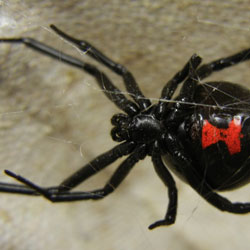The venomous bite of these spiders is considered particularly dangerous because of the neurotoxin latrotoxin, which causes the condition latrodectism, both named for the genus. The female black widow has unusually large venom glands and its bite can be particularly harmful to humans. However, despite the black widow’s notoriety, the bites are rarely fatal. Only female bites are dangerous to humans. Male and female black widows look different. In all cases, the females are the most distinctive, with shiny black bodies and a red hourglass-shaped marking on the underside of their round abdomen. The hourglass marking can, on occasion, also be orange-yellow.
Female black widows are about 1.5 inches long. The males are about half the size of females. Males are lighter in color, with red or pink spots on their backs.
They may be found in dark, dry shelters such as barns, garages, basements, crawlspaces, hollow stumps, rodent holes, trash, brush and dense vegetation.
Prevention Tips
Watch out for black widow spiders in areas that are dark, warm and secluded.
Decrease clutter in areas that are not frequently disturbed.
Minimize hiding spots. Eliminate non-essential outdoor items, yard debris.
Inspect for webs and sweep down egg sacs.
Dust and vacuum under furniture and around corners of rooms, windows, etc. Vacuum egg sacs and webs and dispose of the bag after the vacuum.
Don’t attract spiders by debris. Remove them all as spiders like to live in and on debris.
Reduce the number of insects by regular pest control and you will reduce all the chances of black widows coming in the house.

